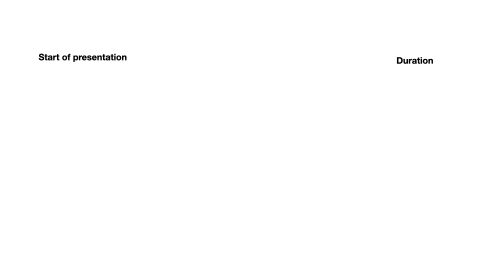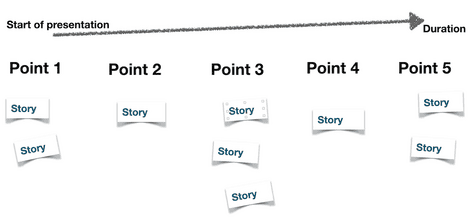
There’s a lot of crap presentations training around at the moment saying “tell stories”… just “tell stores”. That’s about as much use as saying “be tall” to someone struggling because they can’t reach the top shelf. I used to have a problem with Nike’s slogan of “just do it” because I feared it encouraged people to have a go at things which were technically beyond them to the point of being a bit dangerous.
You don’t “Just Do It” with a pole-vault.
(Side note: there’s a video at the bottom of this blog if you’d rather watch me than read).
Let me give you an example of how this Nike-style approach to advocating storytelling messes people up, people based on someone who asked me for feedback on a presentation they made recently. I’ll call this person eM, so that you can’t even tell if it’s male or female. (To be utterly honest, eM is a couple of people brought together, not just one!)
eM had really taken the idea of ‘just do it’ storytelling on board and so the whole structure of their presentation was a series of stories – particularly in the form of case studies. Often, case studies are good! eM was also aware that audiences need tools, not just rhetoric, so scattered throughout the case studies were tips on how to do things.
This gives a strict of “this is what I did and here’s a tool for you to do it too”. It’s a very common formula for presenting.
The problem is that from the audience’s perspective it came across as a series of stories told by eM, about eM.
The advice and tips was lost in the (hugely impressive!) “look what I did” stories.
What had eM done wrong? His/Her (see how careful I am to keep this anonymous?!) story matrix was the wrong way around.
What’s a story matrix?
Seduced by the “need to tell stories tell stories tell stories” eM had, without thinking about it, structured her presentation like the animation below. The driving force of eM’s presentation, was a set of five stories. In theory, each story led to a useful tool or two being mentioned… in practice eM even forgot to do that for some parts of her presentation, but that’s a problem with execution, and what I’m complaining about today is the whole idea of structuring your presentation by stories.

By the way there’s a bigger, static version of this image here: https://presentationgenius.info/wp-content/uploads/2020/12/presentation_story_matrix_wrong-3-1024×500.jpg
The impression is what we (rudely) call in our training sessions, a presentation design from “what I did on my holidays” told chronologically 😉

To make matters worse eM is an expert in what eM does. That means some of the stores aren’t immediately relatable by the audience. The more of an expert you are, the more likely it is that your stories (particularly if they’re about you and what you’ve done/how you did it) will be based on the “hero-cast”? What’a hero cast? Just watch any action/adventure film and see how the hero overcomes seeming insurmountable odds. That’s the whole point of the film! The thing is, if you, as the presenter do that to your audience, they’re just going to sit there thinking “It’s all well and good for you, but I can’t possibly do that!”.
Just because you survived being raised by alligators doesn’t mean people in your audience can (or think they can)!
(Take a look here for an article I wrote about this for the presentation guru website!) and how you can tell if your story is read to be shared with the audience.
A better presentations needs a rotated story matrix
Imagine, for a moment, that eM had rotated that matrix. (I know, I know, I hated having to do matrix rotation calculations at school, too!). Instead of stories along the top, as the driving force of the presentation, eM would have (groups of) useful tools.
And under each useful tool, eM would have a couple of (short!) stores/case studies to illustrate how they could be used. In an ideal eM would use stories based on:
- other people (as well as herself if necessary)
- that the audience recognised themselves in (so that eM’s expertise didn’t feel intimidating)
- short (I’ll say that again… SHORT stories)
From the audience’s perspective it would have felt more accessible and less like a “look at me”.
At this point I should re-iterate something I said right at the start of this blog, I’m not criticising eM or anyone like her! I’m pointing my gun, both barrels at bad presentation skills trainers who spout the simplistic “tell stories, tell stories, tell stories” mantra without explaining anything properly.
So is there any good news about eM’s presentation?
Absolutely! All the content is there – it’s just arranged in a way that worked more for eM than for the audience.
On a boarderline-cynical note, it might even have done eM some good, because situations like this, where the audience looks at the presenter doing things that they can’t begin to achieve to, can make the presenter look more like a guru!
Oh, and yes, even better from eM’s point of view is that he/she pulled it out of the bag at the end with an extensive Q&A session, where eM talked about the tools – because that’s what people asked about… which tells you something about what the audience wanted in the main body of the presentation! 🙂
And if eM wants to make a better presentation, what should she do?
It’s easy – turn the matrix around. Here’s how.
- Start with a clean slate – forget about the presentation as it’s structured at the moment. Put it aside to come back to later as a source of already-researched content
- Look at the things that the audience needs to know – the things that go down in the original story matrix. Put them into groups if you can, so make the presentation shorter. Talking about five groups of things takes less time than talking about 13 different individual things. Not only that but a 13-point presentation will just bore the audience… and they won’t remember things anyway!
- Now that you’ve got the things you want to talk about, but them in the best order for your audience. Simple.
- Finally, go back to your original presentation and pick the stories that best serve the points you’re trying to make and use them to illustrate your points. The stories are no there to support and illustrate the key points, they’re not the key points themselves.

Easy!
Of course, easy doesn’t always mean simple, but you get the idea!
What about you?
If you’ve been told, gentle reader, that you must tell stores… great. Whoever told you that is right. But they might not be helpful. If you’re interested in learning more tools like this – to use stories, in your presentations and not just tell them – you should check out the #ReluctantStoryteller!
Prefer this in a short video presentation?
I recorded a short live about all of this. Here it is!
I want to thank you for the feedback that you gave me on my presentation delivery recently. In my head I thought I was giving value, and of course, that’s not quite how it played out, so thank you for taking the time to give me the constructive feedback that I asked for, so that it gives me the homework to help me improve telling my story at my next speaking gig. Thanks again Simon – May King Tsang, first name May King (inspiration for this latest blog post based on my talk “Creating FOMO for your Brand” which I delivered recently.